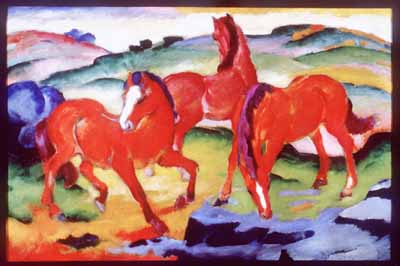Rounding up the ‘Horses’: First U.S. exhibition devoted to Franz Marc’s ‘Horses’ opens at Busch-Reisinger

Harvard’s Busch-Reisinger Museum will present an exhibition offering an intimate look at Franz Marc’s (1880-1916) paintings of horses. “Franz Marc: Horses” brings together a selection of major works by this German Expressionist master in a special installation that explores the artist’s commitment to the spiritual intensity of color in interpreting the natural world.
Opening at the Busch-Reisinger Museum on Sept. 29, “Franz Marc: Horses” is the first exclusive presentation of Marc’s work in the United States in more than 20 years. The exhibition will remain on view through March 18, 2001.
This concentrated group of six masterworks focuses on the canonical painting “The Red Horses” (1911), a promised gift currently on long-term loan to the Busch-Reisinger Museum. Other works included in the exhibition are “Small Blue Horses” (1912) and “Small Yellow Horses” (1911) from the Staatsgalerie Stuttgart, “Large Blue Horses” (1912) from the Walker Art Center in Minneapolis, and two highly significant later paintings from the Solomon R. Guggenheim Museum in New York, “Stables” and “The Poor Country of Tyrol,” both from 1913.
As a complement to “Franz Marc: Horses,” the Busch-Reisinger Museum will present the exhibition “The Blue Rider Artists: Works on Paper from the Busch-Reisinger Museum and Other Harvard Collections” (Dec. 23-March 18, 2001).
“‘Franz Marc: Horses’ will bring these extraordinary paintings together for the first time in the U.S., allowing us to study and appreciate the resonance between Marc’s provocative subject matter and abstract use of color,” said James Cuno, the Elizabeth and John Moors Cabot Director of the Harvard University Art Museums. “The Art Museums have a history of providing a platform for scholarship associated with this important artist; in 1941, the Busch-Reisinger Museum hosted the first exhibition in the U.S. devoted to Marc’s work. ‘Franz Marc: Horses’ offers an opportunity for careful examination of a subject that illuminates key aspects of Marc’s aesthetic style and artistic evolution.”
Franz Marc dedicated a major part of his tragically short life to painting animals, and his mystical depictions of horses today count among the icons of classic modernism. “Franz Marc: Horses” explores how this co-founder of the Munich-based Expressionist Blue Rider group created visionary images evoking his understanding of the pureness and innocence of the animal world. The visitor will also have a sense of the trend toward abstraction in Marc’s work in the years before the outbreak of World War I. The complementary exhibition “The Blue Rider Artists” puts Marc’s horses and the greater body of his work into the context of a major movement born in part from his personal artistic motivation.
“Franz Marc: Horses,” complemented by “The Blue Rider Artists,” promises to deepen our appreciation for Marc’s mastery of vibrant color and rhythmic composition as seen in the larger context of German Expressionism,” said Peter Nisbet, Daimler-Benz Curator of the Busch-Reisinger Museum. “We are delighted to have this unique opportunity to present ‘Franz Marc: Horses’ and a number of important works by Blue Rider artists in the galleries simultaneously, which will allow viewers to increase their understanding of this pivotal movement in 20th century art.”
‘Blue Rider Artists’
Through groundbreaking exploration of color and form, artists associated with the 1912 publication “The Blue Rider” sought to free artistic expression from the constraints of tradition and to tap more directly into the human psyche and spirit.
Opening on Dec. 23, “The Blue Rider Artists” presents the University’s strengths in holdings of works by Marc and this influential group of artists. The exhibition includes works by Wassily Kandinsky, Paul Klee, August Macke, Heinrich Campendonk, Alexei von Jawlensky, and Alfred Kubin, and brings together important works that have not been exhibited at the Art Museums as an independent group since 1955. These works on paper offer insight into the artists’ processes as they develop their ideas in watercolor, gouache, oil, graphite, and ink. Prints such as woodcuts, etchings, drypoints, and lithographs, as well as printed books, including the almanac “The Blue Rider” (1912), will also be shown.
The museum is open Monday through Saturday, 10 a.m.-5 p.m., and Sunday, 1-5 p.m., and is closed on national holidays. Admission is $5; $4 for senior citizens; $3 for students; free under 18 and for all individuals on Saturdays until noon and all day on Wednesdays.




